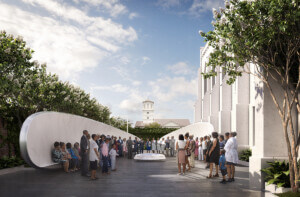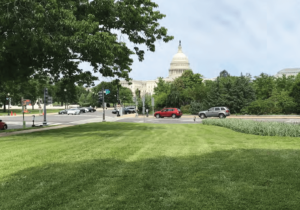In early March, just as case numbers and mask requirements were dropping, the New York Times editorial board published an opinion piece titled “Why New York Needs a Covid Memorial.” City and citizens, the op-ed argued, would be stronger if it could “confront its grief instead of trying to outrun it.” The authors were necessarily hazy about shape and size, style and site, but particular about the need for a place for people to gather and mourn.
In year three of the pandemic, the United States is just shy of a million COVID-related deaths. Global deaths are six times that number, with each data point representing an individual with a constellation of loved ones, friends, co-workers left behind. Clearly, there’s a need to honor the dead. But when and how?
In a country fragmented by pandemic politics, there is no mandate for an architecture of remembrance. Thousands of white flags, a COVID memorial artwork by Suzanne Brennan Firstenberg titled In America: Remember, covered the National Mall in Washington, D.C., last fall, but the installation lasted only a few weeks.
In blue counties like Los Angeles, where I live, day-to-day COVID anxieties have lessened, but the worries about impending Omicron variants remain heavily present. There’s not yet the bandwidth for reflection. In red counties, places resistant to vaccines and aswirl in 5G conspiracy theories, recognizing loss would legitimate factual realities some would rather circumvent.
Between these two poles is a yawning gap where lives used to be.
Left with absence, rage, and uncertainty, but no consensus or unity, we face a question: Are we (we the country, we the field) ready for a COVID-19 memorial? Should we start bracing ourselves for the inevitable ideological fights, both in the political arena and within architecture culture? Just wondering who might be selected to design any memorial is certain to provoke disagreement.
In fact, it already has. Last year, The Atlantic and New York Magazine, through its offshoot Curbed vertical, asked artists, designers, composers, and architects to speculate. MASS Design Group’s Michael Murphy suggested a spectacular forest on the Mall. Daniel Libeskind inexplicably caged Lady Liberty in half a million steel bars. And Sekou Cooke proposed an Unmonument, an empty pedestal reminiscent of the base that once held a statue of Confederate general Robert E. Lee in Richmond, Virginia, reminding readers that not only are monuments temporary, many also come with deeply racist histories.
Then in July, Dezeen reported that Heatherwick Studio had met with U.K. government officials to discuss COVID-19 commemoration. The very idea that the same designer who authored Vessel, an extravagant, suicide-enabling, doner kabab–resembling sculpture and the billionaire folly Little Island could be picked for such an important task set off ripples of dissent across the internet. Almost immediately, the studio sought to distance itself from any monument, rejecting the claims and noting that no plans to design a memorial were ever in the works.
Maya Lin’s Vietnam Veterans Memorial is often cited as a universal monument.
Her piece comes up in nearly every recent article that tries to unspool what a COVID-19 memorial should look like. It’s celebrated for achieving formal and emotional cohesion: a simple black marble wall inscribed with names, a sculpture that invites collective remembrance across all political stripes. But when it opened on the National Mall in 1982, just seven years after the fall of Saigon, it sparked criticism of its design and apolitical position on a war that had deeply divided the country and created cultural fissures that are still with us today. “It was extremely naïve of me to think that I could produce a neutral statement that would not become politically controversial simply because it chose not to take sides,” wrote Lin in a 2000 essay for The New York Review.
According to James Reston Jr., author of A Rift in the Earth: Art, Memory, and the Fight for a Vietnam War Memorial, the design was deemed too abstract and not sufficiently patriotic. Lin’s identity as a young Chinese American woman came under attack. Critics claimed it insulted veterans—a black, gravelike trench as opposed to the gleaming white marble monuments elsewhere on the Mall.
In 1984, a supposedly corrective statue was added nearby: a representational bronze depicting three weary servicemen by prolific monument maker Frederick Hart. Lin saw its installation as an attempt to undermine her design, which has since become a model for nonfigurative memorials. “It’s taken me years to be able to discuss the making of the Vietnam Veterans Memorial, partly because I needed to move past it and partly because I had forgotten the process of getting it built,” wrote Lin in the introduction to her 2000 essay.
The process of memorialization is painful. As much as we want something—architecture, art, landscape—to initiate acts of collective healing, there’s no balm other than the steps of grieving. Our present moment is still unbearably raw. I watch case numbers tick higher because of the BA.2 variant and read indictments of Trump supporters who stormed the Capitol on January 6, all against the backdrop of the war in Ukraine. News reports announce that Kyiv and Odesa residents stacked thousands of sandbags to protect civic monuments, symbols of cultural history and independence.
I’m reminded of a line by artist Robert Smithson, who in discussing entropy and the work of his 1966 contemporaries wrote, “Instead of causing us to remember the past like the old monuments, the new monuments seem to cause us to forget the future.” These new monuments, made out of plastic or light fixtures, not marble or granite, were indicative of his present moment, and rather than being built for the ages, were suspended in time.
Eagerness to make a memorial to those lives taken by the pandemic anticipates its end. It’s motivated by the need to mourn but also by the multiple polarizing desires to put things (protocols, lockdowns, illness, death) in the past so that we might get quickly to a COVID-free future—a return to normal that proves ever more elusive. Instead of monuments we are surrounded with entropic architectures.
Geoff Manaugh and Nicola Twilley begin their 2021 book Until Proven Safe with the description of an Econo Lodge sign painted black to indicate the use of the former motel as a quarantine site. They trace the snaking lines of yellow barricades used to cordon off infected neighborhoods in Wuhan, China, and draw parallels with the markings and battens used to isolate plague-infected households in 16th-century Italy.
But by and large, the impact of the pandemic on the built environment in the United States is a series of less ominous banalities. Outdoor dining sheds are weathered after another winter. Portable tents and vinyl signage assembled as testing sites still crop up in parking lots. Stickers and tape installed on floors and sidewalks two years ago to remind people to stand six feet apart are now peeling, gummy patches.
These are our everyday memorials. Small acts of memory that are more akin to artist Robert Smithson’s A Tour of the Monuments of Passaic, New Jersey, a celebration of crumbling infrastructure rather than heroic statuary. At some point, not now, an architectural vision for a monument may emerge and gain traction. But for now, remembrance is in smudged Plexiglas at the bodega register and empty hand sanitizer kiosks.
Mimi Zeiger is a Los Angeles–based journalist, critic, and curator.











